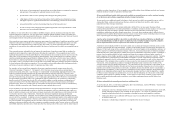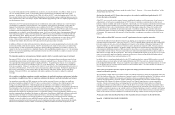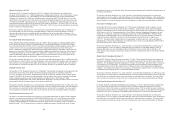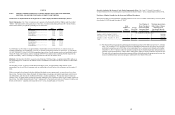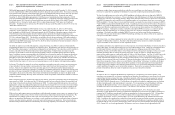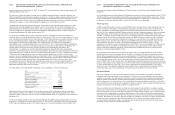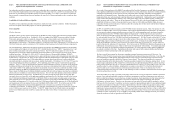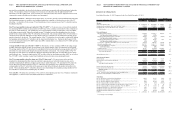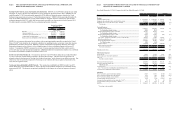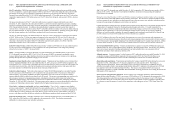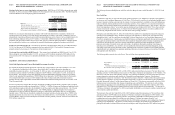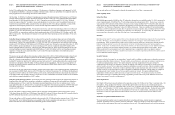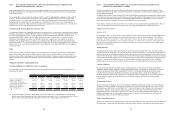Dish Network 2012 Annual Report Download - page 35
Download and view the complete annual report
Please find page 35 of the 2012 Dish Network annual report below. You can navigate through the pages in the report by either clicking on the pages listed below, or by using the keyword search tool below to find specific information within the annual report.
Item 7. MANAGEMENT’S DISCUSSION AND ANALYSIS OF FINANCIAL CONDITION AND
RESULTS OF OPERATIONS - Continued
58
58
domestic retail stores as of December 31, 2012. In January 2013, we announced the closing of approximately 300
additional domestic retail stores.
We continue to evaluate the impact of certain factors, including, among other things, competitive pressures, the
ability of significantly fewer Blockbuster domestic retail stores to continue to support corporate administrative costs,
and other issues impacting the store-level financial performance of our Blockbuster domestic retail stores. These
factors, or other reasons, could lead us to close additional Blockbuster domestic retail stores. In addition, to reduce
administrative expenses, we moved the Blockbuster headquarters to Denver during June 2012.
Our Blockbuster UK Operating Entities entered into Administration in the United Kingdom on January 16, 2013.
Administrators have been appointed by the English courts to sell or liquidate the assets of the Blockbuster UK
Operating Entities for the benefit of their creditors. Since we no longer exercise control and the administrator now
exercises control over all operating decisions for the Blockbuster UK Operating Entities, we will be required to
deconsolidate Blockbuster UK during the first quarter 2013.
As a result of the Administration, we have written down the assets of Blockbuster UK to their estimated net
realizable value on our Consolidated Balance Sheets as of December 31, 2012, and we recorded a charge to “Cost of
sales - equipment, merchandise, services, rental and other” of $21 million during the year ended December 31, 2012
on our Consolidated Statements of Operations and Comprehensive Income (Loss). Furthermore, we have
intercompany receivables due from Blockbuster UK of approximately $37 million that are eliminated in
consolidation on our Consolidated Balance Sheets as of December 31, 2012. Upon deconsolidation of Blockbuster
UK in the first quarter 2013, these intercompany receivables will no longer be eliminated in consolidation. We
currently believe that we will not receive the entire amount for these intercompany receivables in the
Administration. Accordingly, we recorded a $25 million impairment charge related to these intercompany
receivables, to adjust this amount to their estimated net realizable value for the year ended December 31, 2012. This
impairment charge was recorded in “Other, net” within “Other Income (Expense)” on our Consolidated Statements
of Operations and Comprehensive Income (Loss) and the resulting liability was recorded in “Other accrued
expenses” on our Consolidated Balance Sheets as of December 31, 2012. The $25 million impairment liability will
be offset against the intercompany receivables that will be recorded upon deconsolidation in the first quarter 2013.
In total, we recorded charges described above totaling approximately $46 million on a pre-tax basis on our
Consolidated Statements of Operations and Comprehensive Income (Loss) for the year ended December 31, 2012
related to the Administration. The proceeds that we actually receive from the Administration and the actual
impairment charge may differ from our estimates.
As of December 31, 2012, Blockbuster UK had total assets and liabilities as follows (in thousands):
Cash.......................................................................... 14,072$
Trade accounts receivable........................................ 1,153
Inventory.................................................................. 34,937
Other current assets.................................................. 10,243
Restricted cash and marketable securities................ 484
Property and equipment........................................... 186
Trade accounts payable............................................ (13,081)
Intercompany payable.............................................. (36,676)
Deferred revenue and other...................................... (1,369)
Other accrued expenses............................................ (9,949)
Total net assets...................................................... -$
Upon deconsolidation in the first quarter 2013, the above amounts will be combined into one net asset and the
intercompany receivables of $37 million, net of the impairment liability of $25 million described above, will be
recorded in “Other noncurrent assets, net” on our Consolidated Balance Sheets as a component of our investment in
Blockbuster UK.
For the years ended December 31, 2012 and 2011, Blockbuster UK had $293 million and $242 million of revenue,
respectively. In addition, for the years ended December 31, 2012 and 2011, Blockbuster UK had an operating loss
of $31 million and operating income of $16 million, respectively. Upon deconsolidation in the first quarter 2013,
Item 7. MANAGEMENT’S DISCUSSION AND ANALYSIS OF FINANCIAL CONDITION AND
RESULTS OF OPERATIONS - Continued
59
59
the revenue and expenses related to Blockbuster UK will no longer be recorded in our Consolidated Financial
Statements.
Our Consolidated Statements of Operations and Comprehensive Income (Loss) for the years ended December 31, 2012
and 2011 include the results of operations for Blockbuster for twelve months and eight months, respectively. We did
not have any Blockbuster activity during 2010 as we acquired Blockbuster on April 26, 2011. Therefore, our results
of operations for the years ended December 31, 2012, 2011 and 2010 are not comparable.
Wireless Spectrum
In 2008, we paid $712 million to acquire certain 700 MHz wireless spectrum licenses, which were granted to us by
the FCC in February 2009 subject to certain build-out requirements. On March 2, 2012, the FCC approved the
transfer of 40 MHz of 2 GHz wireless spectrum licenses held by DBSD North America and TerreStar to us. On
March 9, 2012, we completed the DBSD Transaction and the TerreStar Transaction, pursuant to which we acquired,
among other things, certain satellite assets and wireless spectrum licenses held by DBSD North America and
TerreStar. In addition, during the fourth quarter 2011, we and Sprint entered into the Sprint Settlement Agreement
pursuant to which all issues then being disputed relating to the DBSD Transaction and the TerreStar Transaction
were resolved between us and Sprint, including, but not limited to, issues relating to costs allegedly incurred by
Sprint to relocate users from the spectrum then licensed to DBSD North America and TerreStar. Pursuant to the
Sprint Settlement Agreement, we made a net payment of approximately $114 million to Sprint. The total
consideration to acquire these assets was approximately $2.860 billion. This amount includes $1.364 billion for the
DBSD Transaction, $1.382 billion for the TerreStar Transaction, and the net payment of $114 million to Sprint
pursuant to the Sprint Settlement Agreement. The financial results of DBSD North America and TerreStar are
included in our results beginning March 9, 2012.
We generated $1 million and less than $1 million of revenue for the years ended December 31, 2012 and 2011,
respectively from our wireless spectrum segment. In addition, we incurred a $64 million operating loss and less
than $1 million in operating income for the years ended December 31, 2012 and 2011, respectively. We incur
general and administrative expenses associated with certain satellite operations and regulatory compliance matters
from our wireless spectrum assets. We also incur depreciation and amortization expenses associated with certain
assets of DBSD North America and TerreStar. This depreciation and amortization expense is based on our estimate
of the fair value of these assets as disclosed in Note 10 in the Notes to the Consolidated Financial Statements in Item
15 of this Annual Report on Form 10-K. As we review our options for the commercialization of this wireless
spectrum, we may incur significant additional expenses and may have to make significant investments related to,
among other things, research and development, wireless testing and construction of a wireless network.
Operational Liquidity
Like many companies, we make general investments in property such as satellites, set-top boxes, information
technology and facilities that support our overall business. However, since we are primarily a subscriber-based
company, we also make subscriber-specific investments to acquire new subscribers and retain existing subscribers.
While the general investments may be deferred without impacting the business in the short-term, the subscriber-
specific investments are less discretionary. Our overall objective is to generate sufficient cash flow over the life of
each subscriber to provide an adequate return against the upfront investment. Once the upfront investment has been
made for each subscriber, the subsequent cash flow is generally positive.
There are a number of factors that impact our future cash flow compared to the cash flow we generate at a given
point in time. The first factor is how successful we are at retaining our current subscribers. As we lose subscribers
from our existing base, the positive cash flow from that base is correspondingly reduced. The second factor is how
successful we are at maintaining our subscriber-related margins. To the extent our “Subscriber-related expenses”
grow faster than our “Subscriber-related revenue,” the amount of cash flow that is generated per existing subscriber
is reduced. The third factor is the rate at which we acquire new subscribers. The faster we acquire new subscribers,
the more our positive ongoing cash flow from existing subscribers is offset by the negative upfront cash flow
associated with new subscribers. Finally, our future cash flow is impacted by the rate at which we make general
investments and any cash flow from financing activities.


